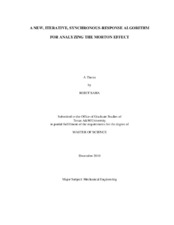| dc.description.abstract | The present work proposes a new computational algorithm for analyzing Morton
Effect using a Successive Iterative Synchronous Response Algorithm (SISRA). Previous
studies on the Morton Effect were based on Eigen or Nyquist analysis for stability
studies and predicted only an onset speed of instability. The outcome of SISRA is the
convergence of response to a steady state orbit in a finite number of iterations. A
progressive increase in the response with increasing running speed indicates the former
instability. SISRA predicts both the synchronous response for the speed range of concern
plus the speed where the response becomes divergent.
SISRA is implemented in a Timochenko-beam-based finite-element
rotordynamics software suite. SISRA analyzes the Morton Effect as a synchronous
response problem with excitations from: (1) mechanical imbalance, (2) induced thermal
bent shaft moments, and (3) mechanical imbalance that is induced by thermal bow. A
general elliptical orbit can be decomposed into the sum of forward and backward
circular orbits. As input, SISRA requires that, at a specified speed, equilibrium position, and orbit: (1) the predicted maximum differential temperature, and (2) the angle between
hot spot (position of maximum temperature) and position of minimum film thickness.
Two examples from the published literature are considered. SISRA predicted
higher vibration levels, even before the motion diverges due to Morton Effect. In some
cases, the synchronous response of the system due to Morton Effect is orders of
magnitude greater than the response due only to mechanical imbalance. The combined
effects of: (1) mechanical imbalance with induced thermal bent shaft moments, and (2)
mechanical imbalance with thermally induced mechanical imbalance are also studied.
The impact of induced thermal bent shaft moments is found to be greater than the
mechanical imbalance induced by thermal bow.
A parametric investigation on the impact of the changes of (1) bearing length to
diameter ratio, (2) reduced viscosity of the lubricant, (3) bearing radial clearance to
radius ratio and (4) overhung mass magnitude is performed to consider their respective
impacts on synchronous response. Based on the available input data and the cases
considered, reducing viscosity and reducing the overhung mass are found to be the best
remedies to alleviate problems arising from the Morton Effect. | en |


